Endurance tests on a bicycle trip, 30 August - 9 September 2013
I will be using the following bags:
- Rear bags: MSX SL 55 Elegance MX black.
I actually wanted the CX without mount for additional bag on the outside which didn't interest me, but it wasn't in stock and I needed bags already for daily use). Weight ca. 1250 g per bag, 2500g total, which is quite a bit more than the Ortlieb Backroller plus (1700g per specification for 2 bags and similar size). Perhaps I will get one of the Ortliebs to try both at the same time. Brooks has a "Land's end bag" which seems almost a carbon copy of the Backroller, but twice as expensive (The price is not cool! As with so many recent Brooks products prices are just way too high, more for fashionistas than those who love good quality gear).
Size:
Size (inner):
Weight: 1250g per bag, so 2500g total.
Experiences to follow.
Pictures to follow
- Front bags: MSX ML 55 Elegance CX.
Size (inner):
Weight: 1060 g per bag, so 2120 g total
Pictures to follow
- Handlebar bag: MSX CLS 55 Elegance MX.
Size (inner):
Weight: ? (excluding klickfix, including klickfix plate)
Pictures to follow
Lighting that I wanted to use, test and compare [ the deleted items I took with me, but didn't use due to cutting my trip short ]:
Axa Luxx 70 plus- B&M Luxos U
Sheng li Banklight (but I will only use this as a USB power source)- Experimental LED driver, with my taillamp idea incorporated into a modified standard taillamp
Bidi Triple LED dynamo headlamp- Philips Lumiring (oval rack mounted taillamp)
Philips Lumiring battery, flashing (oval rack mounted taillamp)- Philips Lightring (round seatpost mounted taillamp)
- B&M Secula (fender mounted taillamp)
- Selfmade 'arrow' taillamp
Navigation and electronic stuff that I took with me:
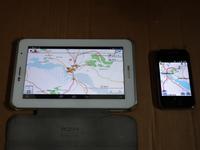
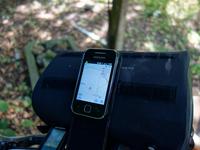
The Samsung Galaxy Y shown here has been unreliable in NL for long distance navigation, restarting at various times during navigation or even switching off when in my backpack. I suppose it's because the housing is not rigid enough and vibrations cause loss of contact with the battery, but I don't want to be stranded without navigation (and the Tab2-7 is too big to use while cycling, how to mount it? Not sure...) so I got a Galaxy S2 as backup.
ML-102 charger for 18650 cells, which I will also use as a powerbank using various loose 18650 cells. I use 18650s in a torch as well. Charging is done via mini-USB:
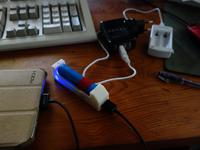
Testing USB power from the Sunup eco DS for which I made a USB output using a 7805 linear regulator (works well, charges devices faster than the Luxos U), and testing the USB output of the special dynamo driver:
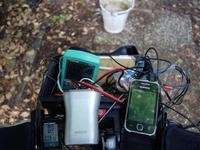
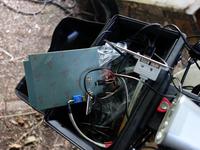
Here is a mount I made to mount two taillamps on the rear rack for testing:
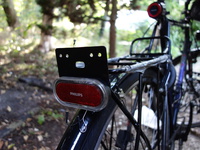
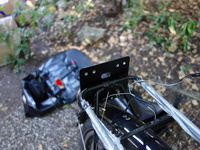
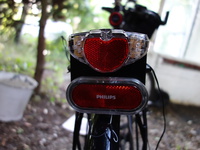
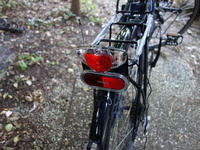
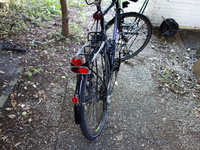
And here is my idea for a new kind of taillamp. I mentioned this idea to a friend quite a while ago, now I made one for the special dynamo driver and will test it on the trip:
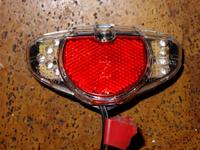
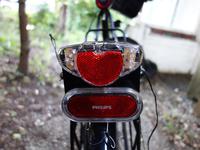
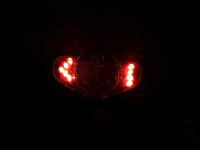

The idea is to let drivers know they should go to the left :) For countries where they drive on the wrong side, I suppose it would be nice that the taillamp can be reversed.
To test this idea bare LEDs mounted on a piece of PCB would be good enough, but for my trip I modified an existing taillamp. This taillamp is fairly resistant to water as there's no fragile electronics inside, so it could be reversed and used in England for example, but a proper waterproof version should be made...
Results in NL and Germany
Roads in Germany
My trip ended far sooner than I wanted due to several issues, one of them the breaking off of a lowrider mount. This wasn't unexpected after I experienced the German roads, which are far worse than Dutch roads. The bags on the lowriders rattled and the lowriders were moving and twisting from that all the time. Not good since they are made from aluminium and aluminium can't handle deformation. So I feared this might happen from the start, if the roads didn't get better. I'm pretty sure Ukrainian roads (my original goal) in cities are no worse, possibly less bad than in Germany. There are bad patches on Ukrainian roads which are mainly an issue for cars at high speed, and in cities roads in Ukraine that I've seen are as least as good as in Germany.
Germany is supposed to be the richest country in Europe, but that money obviously doesn't get spent on roads... And I don't mean just bicycle paths, I mean all roads. I've ridden a lot on the main roads even when there were bicycle paths because the bicycle paths are often just awful in Germany. Not just the road surface, the transitions between it and crossing roads, it's like jumping up curbs all the time. Anyway the main roads often have damage, holes or when 'fixed', patches which are a bit higher than the main road surface and thus give bumps. Fixes are often worse than holes... (this is true everywhere, not just in Germany, and you may want to think about the consequences of riding over a hole vs. a bump and then you will realise that if the hole isn't too wide, it's better to ride over holes than over bumps from filling them up...) And then there are road surfaces with some types of stones (kasseien in Dutch) which simply give incredibly bumpy roads and which seem to have been laid there for esthetic purposes only. We have some in NL too, but I never experienced it this bad...
Then there are cycle paths which drop down at each exit before a house, this is just nuts! How in the hell are you supposed to ride on such roads with any speed? Some of the things I've seen in Germany make me think bicycles are not taken seriously as a means of transport here.
Then the main roads: In Germany you may ride on roads designated 70 km/h if there is no bicycle path. But this doesn't mean it's comfortable riding there. It's not at all comparable to riding on 60km/h shared roads in NL. The reason is that a very large part of German drivers don't drive at 70 km/h or less, but I estimate 40% or more rides at 100+ km/h (yes, I did measurements to see how fast motorists were going). This makes it uneasy and extremely noisy. Lots of people seem to feel the need to show off their noisy engines and in one case I even spotted a car doing ca. 180 km/h on such a road and shortly after that a motorcycle going ca. 200 km/h (calculated by measuring the time between posts on the roads that are 50m apart).
This doesn't surprise me as I've seen very few police cars. It seems in Germany policing isn't done as much as in NL either, so there's probably little chance of speeding tickets...
The noise was another issue that was noticeable in Germany, it's just everywhere! Even in small villages, often roads going through it that are 70km/h (in NL it would have been 50km/h) and of course 70 km/h is not what many motorists ride at...
When I got back to NL I experienced again how much better the roads here are, also in the less densely populated provinces in the east, near Germany. Noticeable is how much more smooth the transitions are between road surfaces than in Germany, but also the road surfaces on main roads and bicycle paths are far better. Even brick roads were better than many of the asphalt roads with repaired patches in Germany...
While I was cycling in Germany, I was thinking about the money being put into eastern Germany. Is that still an issue and perhaps a reason why many of the roads are bad? But lots of issues are not related to money, such as the non existant guidance on roads to cycle paths, or the almost-curb jumping or the cycle paths which go down and up at each driveway of a house.
Another thing I miss in Germany compared to NL is enough signs to other cities for bicycle paths.
Lowriders: Why are some made from aluminium?
But now we come to an interesting question: Why are some lowriders made from aluminium, and why can't they handle the conditions I rode in? Surely German roads, though poor compared to Dutch roads, are not the worst I could encounter? Surely lowriders must be able to withstand much more? Whatever is going on, I will buy steel lowriders to replace the aluminium ones that came standard on this bike.
Streetlights in Germany
This also surprised me enormously: There is almost no street lighting between villages/cities. I suppose this makes Germany a paradise for testing bicycle lamps! But it is hard to find bicycle paths a lot of the time also because transitions from one side of the road to the next are often not indicated. Often I saw a sign 'end of bicycle path' so I rode on the main road, but then a bit later I found out there was a bike path on the other side. In Germany bike paths are often on the wrong side just as in NL, but in Germany it is even more often so than in NL, and even worse is that it happens a lot within cities which can be very confusing. Then outside cities such transitions are not indicated, whereas in NL, if a bike path continues on the other side of the main road, then stripes to guide you to that other side are painted on the road.
Even within cities/villages in Germany, there are very few street lights.
Hills and chain wear
I had a spare chain with me, and after about 500km in the hilly mid part of Germany (on many hills, with ca. 37kg of bags and contents, I went at just 6-8 km/h on the 28/28 gear which means there must be a lot of strain on the chain), I checked my chain checker and the chain, which had almost no wear at the start, it had only seen light use in NL, was worn... This proved what I thought before, that the way you ride (when not riding in hills) is one of the main causes for wear. As I accelerate quickly (I have broken several chains in the past while starting from a a traffic light) this means a lot of stress and thus a lot of wear. I've never had a chain (7,8,9 speed) last more than 2000 km, and this time was no exception.
USB power: Mobile phone charging while riding
The Galaxy S2 just cannot be used with Osmand to navigate, even with screen off and using the voice guidance, when powering it with the Sunup in hilly terrain (where my average was just 15 km/h), it sucks power faster from the battery than the Sunup can replenish. To counteract this Osmand should be modified to use less GPS position checking and other stuff can perhaps be postponed too until the screen is activated again.
The Galaxy Y can just be powered but if you forget to power off the navigation when resting for half an hour or so, it will suck your battery dry. Again, something should be changed in Osmand to make it bike friendly. This is true too for the mode where the map is rotated in the direction of riding, which just doesn't work well, but more on that later.
All in all it showed how hard it is to be fully self sufficient when using a smart phone for navigation. I was constantly trying to keep my batteries from going flat... It also shows what I mentioned on my main bicycle lighting pages, that dynamo power needs to be higher at lower speed and thus this experience confirms my view that the SONdelux is a useless dynamo (esp. when you want to power USB devices with the dynamo, and/or if you ride on roads where some of them are on steep hills and you need as much power as possible at low speed to see where you are going).
USB power: ML-102 and solar power
Charging the Tab2-7 is most problematic. The Banklight doesn't work, it immediately lets the battery indicator jump to 100% and the Tab thinks it's charged, which it's not. The Tab2 has some problems with the ML-102 as well. At one point it said 'charged' after a few hours in the sun with the ML-102 charging it from a 18650 cell and at the same time the ML-102 was getting power from the solar panel, but battery capacity dropped very quickly, and it wasn't really fully charged. Later charging with a regular power supply charged it properly and it lasted a long time again on a single charge, unlike the experience after charging with the ML-102. I wonder if these problems are caused by a non constant (chopped up) charge current that throws off the Tab2's charge estimation system?
Lights: Luxos U vs Experimental driver with Saferide 60/Pedelec
First I ran the Luxos for a while, then around the time when I got to "De pyramide van Austerlitz" in NL I switched to the experimental driver with Philips Pedelec lamp (without electronics, just the LEDs connected direct to the driver, this is the same lamp as the Saferide 60 except the housing has no button at the top) and the feeling was one of relief! The beam pattern in the Luxos is just awful, with its bad overexposure of the near field and the artefacts, and the experimental dynamo driver, which produces ca. 300 lumen, is a lot better than the Luxos U even in its high mode, it has more throw, is brighter and has more light except at long distance at the sides where the beam of Luxos is a bit stronger at larger widths, but I felt it was not an advantage in almost all situations and if I had used the gutted Saferide 80 instead of the Pedelec 80, then this would be a non-issue.
In Germany I ran the Luxos U until I had to return to NL. So I thought I just had to try it in Germany and see how my taillamp did and how well the Luxos works vs. the experimental driver. Well, the Luxos has problems in technical terrain such as some bicycle paths with hilly sections and here the light output of the Luxos was so low sometimes I could not properly decide where I should ride. Here the experimental driver, which charges a 18650 when it has surplus power from the dynamo (note that the lamp can be set in power setting 1,2 or 3, and in position 1 a lot of power is available to charge the 18650), is far superior as it gives power from the 18650 at low speed if the dynamo doesn't provide enough power, which means a lot more light than the Luxos.
I didn't feel my special taillamp had a real effect, motorists seemed to take care with either setup.
The special dynamo driver doesn't provide that much power to USB until speeds go to 20 km/h and above, this is due to its design of a bike lamp and 18650 charger (for the lamp only) first. But the Luxos wasn't better, it doesn't provide much power with light on, and the initial tests I did at night with the Luxos were positive simply because of the buffer battery, it doesn't provide enough power to charge the Galaxy Y for navigation even with screen at low intensity on longer rides. There was another problem with the Luxos: It just didn't want to charge USB stuff a lot of the time. I could only fix this by switching the lamp off and on again while riding, very disconcerting in Germany where I had almost no light to guide me from streetlighting, so I used a torch to light the bicycle path while doing so on a few occasions.
Police once enquired at night what was going on, with my bike parked beside a main road. I was resting a bit (I was doing a long night ride), and they weren't interested at all in whether my lighting was StVZO compliant (which to be honest it doesn't need to be, being a Dutchman and as my lighting is compliant with Dutch law), only that I had good light... This was just one of 3 times I saw a police car in Germany (I rode about 400km in NL, 1000km in Germany, and I saw more police cars in NL than in Germany...)
B17 Select with Imperial-swallow modification
This worked very well. I've written more about it on my saddle review page Brooks B17 select review section.
The MSX panniers and handlebar bag
The panniers work very well, since the bike trip I've used them almost daily for groceries and transporting things, heavy stuff too, so these have been tested extensively by now and they are as yet still perfect. This is quite different from the sturdy looking/feeling but not very long lasting bags from Dutch brand Hema or other low priced panniers. I will add pictures of all this...
The bags have been used now for more than 2 years (Update Jan. 2018: for more than 4 years now...) and are still as new, no tears or antyhing like that and I used them to transport a lot of heavy stuff. Such bags are worth the money, and I expect it's the same for similar bags from other brands, such as Vaude. The quality is just incomparable with cheap bags.
The handlebar bag is fine but the quickfix mount just sucks, the bag rotates around the handlebar if there's enough stuff in it.
2016-1-11: Front wheel flex while turning with loaded touring
I had about 37kg baggage in total, in the rear bags, front bags, and a backpack on the rear rack. I estimate there was about 12kg in the front bags. This makes the bike ungainly to steer, but a problem was that actually this caused the wheel to deform while turning (the rubber doesn't want to make the turn! :)), which was clear from the fact that when turning left/right, the tyre touched the front fender at the point closest to me. For this reason it's clear that smaller wheels than 622mm are better for loaded touring, along with selecting a spoke pattern that minimises sideway flex, and also of influence is the hub. For this purpose a PD-7 with largish spoke circle is better than a PD-8/PV-8 and similar, as with a larger hub, the spokes become shorter and this means less flex.
Last modified: 2015-2-4













